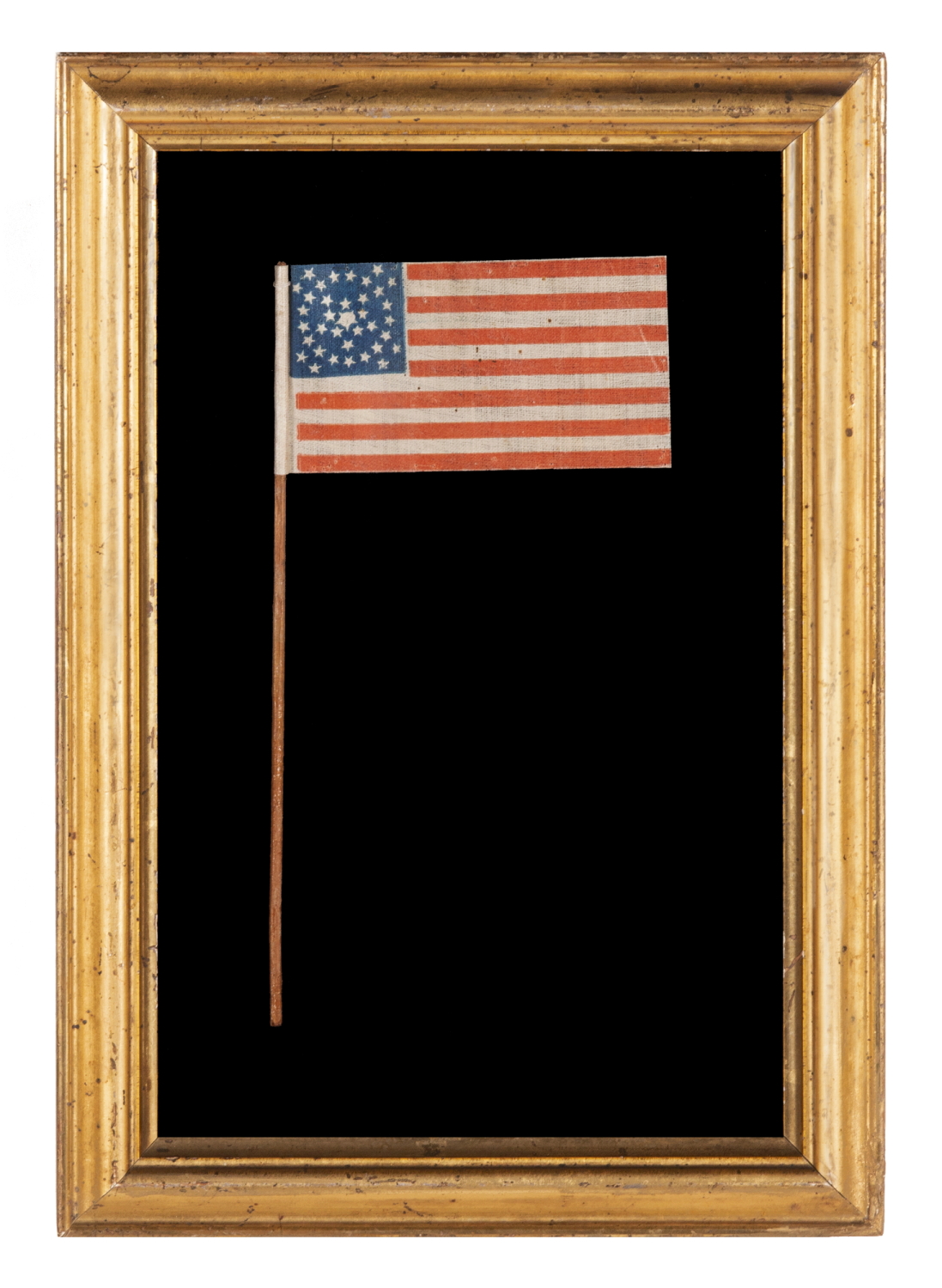


| 36 STARS IN A RARE “GREAT STAR-IN-A-WREATH” PATTERN, WITH 2 OUTLIERS IN EACH CORNER AND A BIG CENTER STAR, ONE OF THE BEST DESIGNS IN ALL OF FLAG COLLECTING, 1864-1867, NEVADA STATEHOOD, CIVIL WAR ERA, FOUND AT NORMANDY FARM, MONTGOMERY COUNTY, PENNSYLVANIA |
|
| Web ID: | 36j-841 |
| Available: | In Stock |
| Frame Size (H x L): | 12.25" x 8.25" |
| Flag Size (H x L): | 2.25" x 4.25" on a 7.75" staff |
| Description: | |
| 36 star American parade flag, printed on glazed cotton, with one of the most rare and beautiful star configurations ever produced. This is comprised of what is known as a “Great Star” star configuration (a star made out of stars), which has a large central star. The Great Star is set within a wreath of stars and is flanked by two stars in each corner. As far as I am aware, the design is unique to this variety of parade flag. There are other known combinations of the Great Star and wreath designs in printed flags, but none have two stars in each corner, which is an exceptionally rare feature. While tiny in size, this could easily be defended as the best geometric star pattern in all of parade flag collecting. For many years I knew of only one group of these parade flags to have been discovered. Found at an auction of the contents of an extremely large working farm (called Normandy Farm) in Eastern Montgomery County, Pennsylvania. The estate belonged to an eccentric member of the Singer Sewing Machine family, who personally did not live on site, but instead chose to reside nearby in a 1950's style motel. The contents included belongings of this family that were accumulated over 150 years, since it was reported that "nothing was ever discarded by them....just placed in storage in attics, lofts, or out buildings." Besides the main house, barn, and expected, additional, farm-related structures buildings, there were other houses and storage buildings on the property. The contents of these were so extensive that the sale required multiple auctioneers, working simultaneously, for a period of three entire days, and still could not liquidate an extensive amount of miscellaneous material that remained. The flags were discovered in a box of holiday decorations, that were sold to an antique toy dealer, from whom they were subsequently acquired by my ex-business partner, more than 20 years ago. The flag that is the subject of this narrative came from the group found at Normandy Farm. I discovered another group in 2010 in the collection of a Michigan antiques dealer, who had owned them for many years. They were found in an original, Civil War period parade flag holder of a type that I had never before encountered. This consisted of a wooden sphere, mounted on a wooden staff, set into a paint-decorated, turned wooden base that terminated on top with a hand-carved, five-pointed star. I have never before seen a group of such extravagant flags in a period flag-holder. Nevada entered the Union as the 36th state, during the Civil War, on Halloween Day, October 31st, 1864. Lincoln pushed it through to statehood just 8 days before the November election. The territory’s wealth in silver was attractive to a nation struggling with the debts of war and so increased support for the Republican ticket. The last Confederate general surrendered on May 26th, 1865. The 36 star flag became official on July 4th, 1865, as that was the day on which stars were officially added, for any states that came in over the previous “flag year,” as prescribed in the Third Flag Act (passed by Congress in 1818). Flag-makers generally ignored official dates, however, particularly as the second half of the 19th century progressed, and would have begun adding a 36th star to their flags in 1864, even before the addition of Nevada had even occurred. Dated examples are known from as early as April of that year. Mounting: The flag was mounted and framed within our own conservation department, which is led by expert staff. We take great care in the mounting and preservation of flags and have framed thousands of examples. The gilded, American molding dates to the period between 1840 and 1870. The flag has been hand-stitched to a background is 100% cotton twill, black in color, that has been washed and treated for colorfastness. Spacers keep the textile away from the glazing, which is U.V. protective glass. Condition: There are some extremely tiny, pinprick-sized stains, but the overall condition is exceptional. |
|
| Video: | |
| Collector Level: | Advanced Collectors and the Person with Everything |
| Flag Type: | Parade flag |
| Star Count: | 36 |
| Earliest Date of Origin: | 1864 |
| Latest Date of Origin: | 1867 |
| State/Affiliation: | Nevada |
| War Association: | 1861-1865 Civil War |
| Price: | Please call (717) 676-0545 or (717) 502-1281 |
| E-mail: | info@jeffbridgman.com |
 |
|